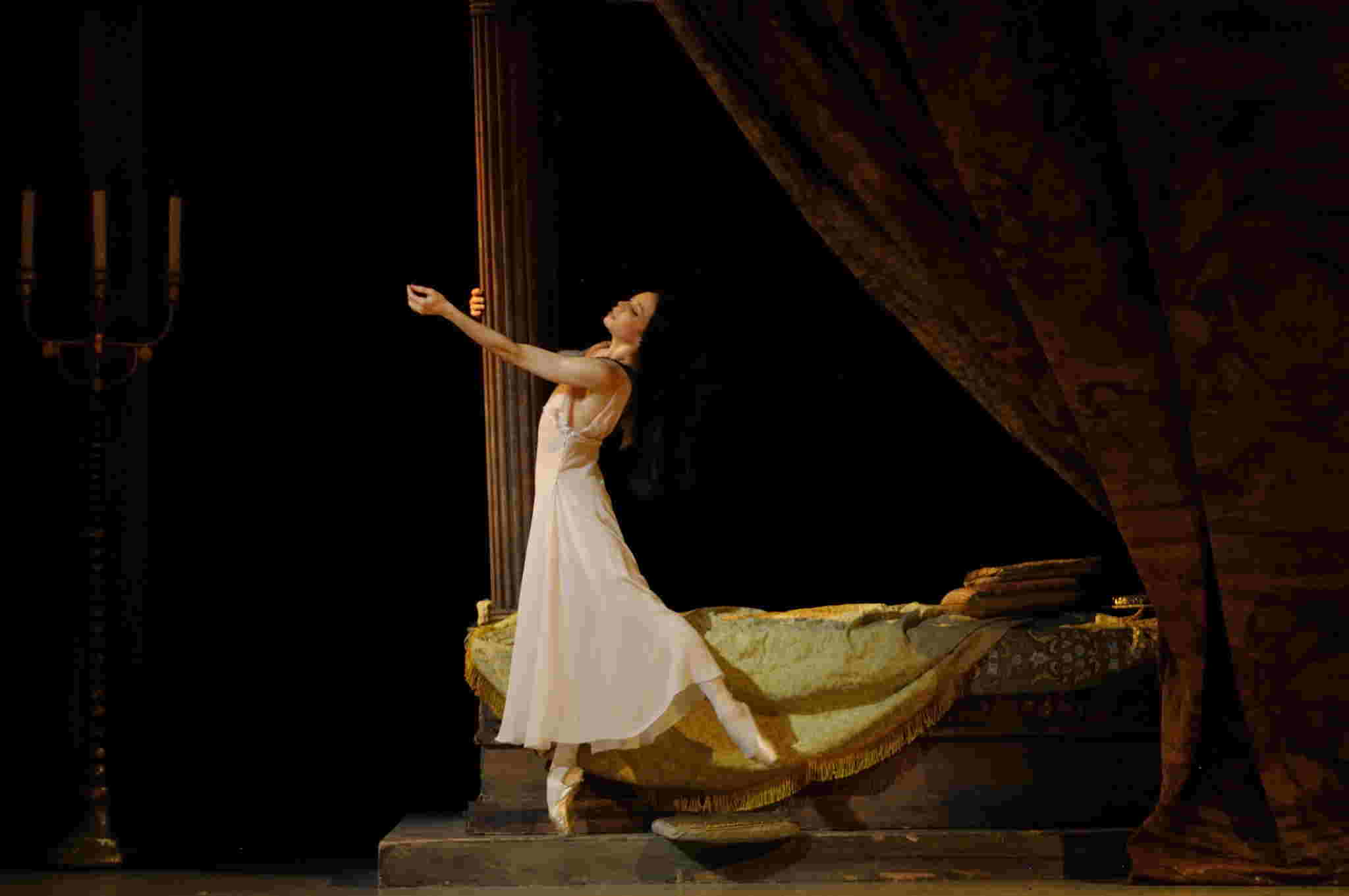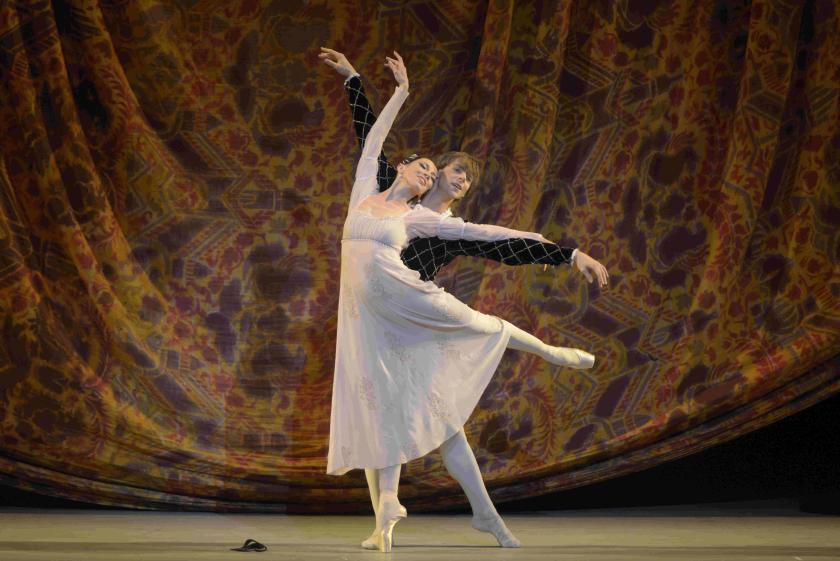One of the reasons I always tell ballet sceptics to give Romeo and Juliet a go is that any production with halfway decent lovers and a vaguely competent rendition of Prokofiev’s score should convince them that this art form isn’t just about swans and sugar plums. The venerable Mariinsky Theatre Ballet of St Petersburg ought, of course, to have dancers and musicians much better than decent, and in its revival of the original 1940 Leonid Lavrovsky version it has a production of great historical weight, yet the St Petersburg visitors were met with only lukewarm appreciation the last time they brought the Lavrovsky Romeo and Juliet to the UK. Fortunately, they seem still to trust enough in the power of Shakespeare+Prokofiev to use it for last night's opening performance of their summer season at the Royal Opera House.
British audiences expecting extended physically intimate pas de deux will be disappointed by all the clipped dance phrases in the Lavrovsky. Steps appear one by one, presaged only by their classroom sequence run-up – coupé, glissade, grand jété, or preparation, run, run, jété entrelacé – with no sense of carrying meaning through a longer musical or movement phrase. The compensation (this is not dance-by-numbers Chabukiani) comes in tableaux of genius: Romeo holding Juliet, arms outstretched, up to the dawn light from the window; Friar Lawrence in his bare cell contemplating a skull for all the world like a quattrocento fresco of St Jerome; mourners kneeling on the steps of Juliet’s tomb with their upcurved white arms briefly conjuring a graceful living pyramid.
Watching Vishneva, my mind kept returning to Margot Fonteyn
The other compensatory factor is the casting of the extraordinarily gifted and compelling Diana Vishneva as Juliet (pictured below). Watching Vishneva, my mind kept returning to Margot Fonteyn. It’s not just the physical resemblance – though there is one between their two pairs of dark, yet lustrous eyes, and the light, fluid quickness that in Fonteyn made Ashton dream of water sprites – but what they used to say of Fonteyn as an actress: that she inhabited her roles naturally, almost without thinking about them, and that for her the steps always came second to (and got their meaning from) the story she was trying to tell. Vishneva has the same instinctual quality: she is completely Juliet, and though her dancing is gorgeous, that pliant body sheer sighing perfection in line after line, you only notice it intermittently, when it would be right for Juliet to be beautiful.
Generally those times are when she’s in the arms of her Romeo, the boyish, handsome, tremendously likeable Vladimir Shklyarov. For all he is capable of both glorious leaps and extremely refined elegancies, Shklyarov too is the kind of dancer who inhabits a role (or at least, this role) completely. His tender, adoring style of partnering is exactly right for Romeo; one of the production’s best moments comes when the curtain rises on Shklyarov’s back while he gazes reverently at a drowsy, ecstatic Vishneva in lying in bed.
When they are inhabiting Romeo and Juliet’s desperate passion, neither Vishneva nor Shklyarov spare themselves the occasional turned-in foot, or dial their speed down so as to land softly and neatly; they are unstoppable as a tidal surge. Shklyarov hurls himself down the steps of Juliet’s mausoleum with bruising, injury-courting force; Vishneva runs so fast that she leaves mostly just an impression of black cloak, airily suspended in her wake like the inky calling card of some vanishing sea creature. You can’t fail to respond to performances this convinced and convincing; when Romeo and Juliet die, it may be with overbaked gestures, but Vishneva and Shklyarov had earned the prickings of tears in my eyes.
 The great gift of the Mariinsky dancers is to wring genuine affect out of melodrama. One feels one is in the presence of greatness, or at least a mysterious alchemy, watching them distil the hammy material of Lavrovsky’s storytelling into a deeply moving, solemn mime language. This gift is by no means confined to the principals – slender Alexander Sergeyev extracts a wry quality from Mercutio’s clowning, and Valeria Karpina endows Juliet’s nurse with remarkable sweetness, despite choreography as stereotypically “comic yokel” as a Worzel Gummidge song – and much of it comes from those Vaganova hands, which adorn even the simplest fourth position with an elegant serif, as curved, necessary and momentarily breathtaking as a comma.
The great gift of the Mariinsky dancers is to wring genuine affect out of melodrama. One feels one is in the presence of greatness, or at least a mysterious alchemy, watching them distil the hammy material of Lavrovsky’s storytelling into a deeply moving, solemn mime language. This gift is by no means confined to the principals – slender Alexander Sergeyev extracts a wry quality from Mercutio’s clowning, and Valeria Karpina endows Juliet’s nurse with remarkable sweetness, despite choreography as stereotypically “comic yokel” as a Worzel Gummidge song – and much of it comes from those Vaganova hands, which adorn even the simplest fourth position with an elegant serif, as curved, necessary and momentarily breathtaking as a comma.
The hammiest excesses are given to the terrifyingly hawk-eyed Vladimir Ponomarev as Lord Capulet and big square-jawed Yuri Smekalov as Tybalt, both of whom have to embody aristocratic evil in order to get the production’s obligatory social and political point across (it was created in 1940). Tybalt is particularly vile, kicking a poor bread vendor, stabbing Mercutio when the latter is off guard, and then turning his back on his dying victim with the arrogant, dismissive droop of a leather-gloved wrist. His punishment for being a nasty aristo (besides dying on Romeo’s sword, of course) is having to spend the entire night in an absurd Marvel Comics-worthy two-tone bodysuit and cape – just looking at him would make anyone long to be a jolly prole doing brisk, bendy character dances with swishy feet and clicky heels.
The vintage art of the painted backcloth is still alive at the Mariinsky
Tybalt’s superman suit and a few duff colour choices aside (russet and tan for the Montagues, urgh), I liked the mostly faithful Italian renaissance aesthetic of the set and costume design, with its carefully Gothic arches, rippling silk damask, and slender columns which capture the difference between the Bolshoi and the Mariinsky in one piece of set dressing. The vintage art of the painted backcloth is still alive at the Mariinsky, too, and out of it we get very fine and atmospheric evocations of umbrella pines over red domed churches, or cypress trees about a vaguely classical mausoleum.
New moments of musico-dramatic genius washed up in my ears as a result of the slow pace Boris Gruzin took with the velvety Mariinsky Theatre orchestra through Prokofiev's score: the low “knocking” of crotchets that signals Juliet’s parents at her bedroom door, ready to change her fate with an announcement of marriage, and the hard, remote, starry sound of the celeste that exactly captures Juliet’s untouchable detachment as she is almost assaulted by Paris (Konstantin Zverev) in her bedroom (another powerful moment follows, when Paris looks into her eyes and then retreats, evidently appalled by the desperation he finds there).
The Lavrovsky may have flaws as a production, but the quality of dancing, acting and musicianship, as well as the sheer passion, displayed by the visitors from the Mariinsky Theatre is easily compelling enough to fall in love with.
- The Mariinsky Ballet are performing Romeo and Juliet at the Royal Opera House until 31 July and several other works in repertory untl 16 August














Add comment